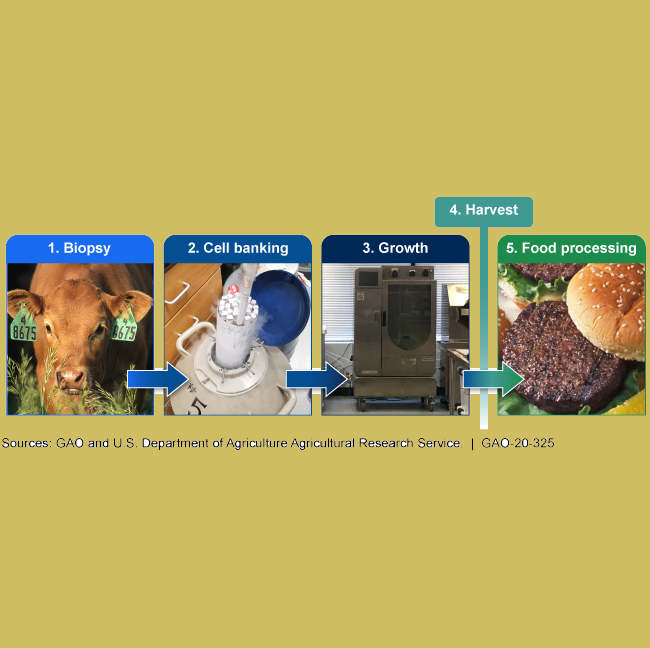SOURCE: FDA.GOV March 31,2023–There is a long history of scientific advances in biology, biochemistry, and engineering that have led to the innovations enabling the growth of animal cells outside of the animal itself, in a controlled environment, for food. The complex process can be broadly summarized in a few steps.
- Step 1: Manufacturers typically start with a sample of cells from the tissue of an animal, a process that does not require harm to or death of the animal. Some cells from the sample are selected, screened, and grown to make a “bank” of cells to store for later use.
- Step 2: A small number of cells are taken from the cell bank and placed in a tightly controlled and monitored environment (typically, a number of sealed sterile vessels of increasing size) that supports growth and cellular multiplication by supplying appropriate nutrients and other factors.
- Step 3: After the cells have multiplied many times over into billions or trillions of cells, additional substances (for example, protein growth factors, new surfaces for cell attachment, additional nutrients) are added to the controlled environment to enable the cells to differentiate into various cell types and assume characteristics of muscle, fat, or connective tissue cells.
- Step 4: Once the cells have differentiated into the desired type, the cellular material can be harvested from the controlled environment and prepared using conventional food processing and packaging methods.
Human Food Made with Cultured Animal Cells
The ability to take a small number of cells from living animals and grow them in a controlled environment to create food made from cultured animal cells is an emerging area of food science. Advancements in cell culture technology are enabling food developers to use cells obtained from livestock, poultry, seafood, or other animals in the production of food.
There is currently no food made from cultured animal cells available for sale in the U.S. market. Manufacturers are generally working on scaling up their processes to consistently produce amounts large enough to be competitively priced. As these products come closer to market, the FDA is closely coordinating with the United States Department of Agriculture’s Food Safety and Inspection Service (USDA-FSIS), which shares jurisdiction over these human food products for certain animal species to ensure that they are safe and accurately labeled. Both agencies are working with manufacturers to ensure these products meet all applicable FDA and USDA-FSIS requirements.
The FDA is continuing to work with firms that are developing food made from cultured animal cells to ensure that the processes used to produce them are safe and lawful under the Federal Food, Drug, and Cosmetic Act. While it is a shared responsibility for the FDA and industry to ensure food is safe, it is the manufacturer’s responsibility to ensure they are marketing food that meets all applicable FDA requirements.
Second Pre-Market Consultation for Human Food Made Using Animal Cell Culture Technology
Before Entering the U.S. Market, the Food Must Meet Federal Requirements…..Constituent Update: March 21, 2023-The U.S. Food and Drug Administration (FDA) completed its second pre-market consultation for a human food made from cultured animal cells. We evaluated the information GOOD Meat, Inc submitted to the agency and have no further questions at this time about the firm’s safety conclusion. The firm will use animal cell culture technology to take living cells from chickens and grow the cells in a controlled environment to make the cultured animal cell food.
The voluntary pre-market consultation is not an approval process. Instead, it means that after our careful evaluation of the data and information shared by the firm, we have no further questions at this time about the firm’s safety conclusion. The FDA’s pre-market consultation with the firm included an evaluation of the firm’s production process and the cultured cell material made by the production process, including the establishment of cell lines and cell banks, manufacturing controls, and all components and inputs.
The FDA is committed to sharing information about our approach to regulating human food made from cultured animal cells. Information about this pre-market consultation is available on the FDA’s Human Food Made with Cultured Animal Cells Inventory (fda.gov).
Human food produced by this firm from cultured animal cells must meet the same stringent FDA requirements, including facility registration and applicable safety requirements, as other food. In addition, the firm will need a grant of inspection from the United States Department of Agriculture’s Food Safety and Inspection Service (USDA-FSIS) for the manufacturing establishment. The food itself also requires a mark of inspection from USDA-FSIS before it can enter the U.S. market. As this product comes closer to entering the U.S. market, we are closely coordinating with USDA-FSIS to ensure it is properly regulated and labeled.
The FDA is ready to work with additional firms that are developing cultured animal cell food and production processes to ensure their food is considered safe and lawful under the Federal Food, Drug, and Cosmetic Act. We encourage firms to engage with us often and early in their product and process development phase, well ahead of making any submissions to the agency. The FDA will issue guidance to assist firms that intend to produce human food made from cultured animal cells prepare for pre-market consultations, and the published draft of this guidance will represent a formal opportunity for public comment and discussion. As we continue to support innovation in food technologies, resulting in more choices for consumers in the marketplace, our priority is the safety of food produced through both new and traditional methods.
Read more at fda.gov
